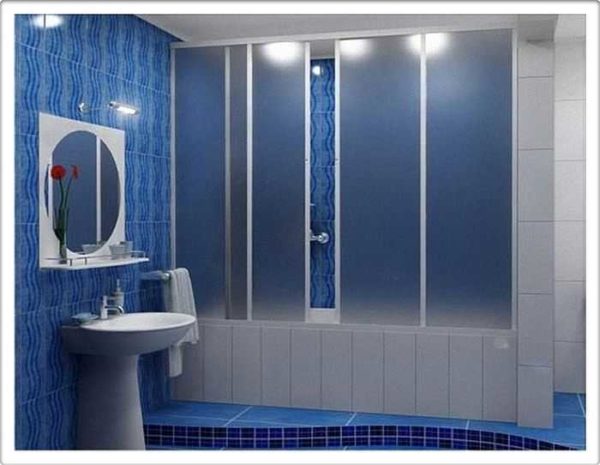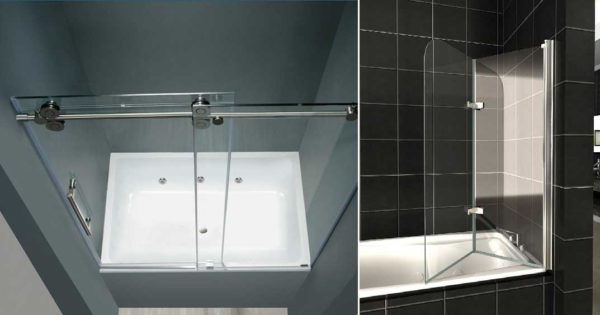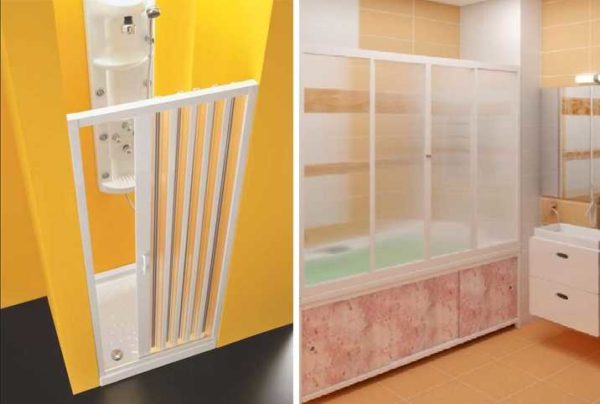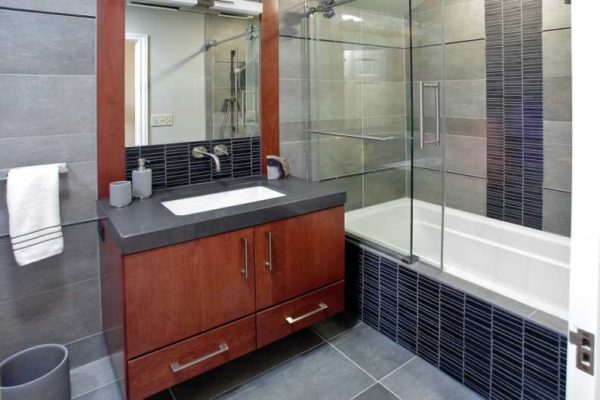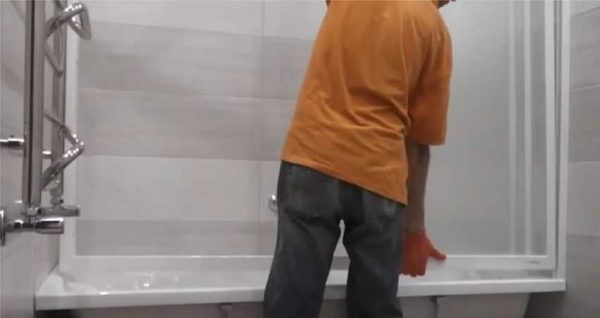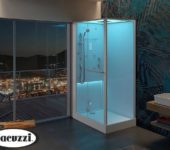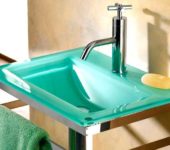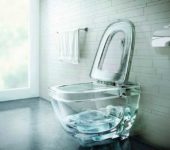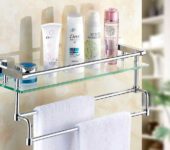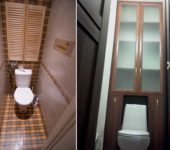Sliding curtains (doors) for the bathroom
A bathroom is one of the smallest rooms in a house or apartment, but its equipment and arrangement is very difficult. The room has difficult operating conditions and a large number of communications, equipment that makes its use more comfortable. For example, in order not to worry about water falling on the floor while taking a shower, sliding bath curtains are installed.
The content of the article
Types and varieties
Sliding bath screens are a convenient way to keep water from splashing in the bath when showering. The cheapest option is fabric (textile) or polyethylene curtains on a special cornice. This is the most budget solution, but it does not provide a 100% guarantee of splash protection. Some part of the water still ends up on the floor.
More expensive - plastic sliding curtains for the bathroom. They are more expensive, but they guarantee moisture protection. Most often they are made of translucent plastic, so that when they are installed, the illumination remains sufficient. In rare cases, when using opaque plastic, the fixtures must be placed directly above the bathroom.
The most presentable, but also the most expensive option is glass sliding bath curtains. They are made of special glass reinforced with a film. Glasses can be transparent, tinted, patterned, they can be painted by sandblasting, painted with stained glass paints, can be found / ordered with photo printing.
Door suspension systems
There are several attachment systems for sliding bath screens. They are used for both plastic and glass modifications. These are wireframe and frameless models. A high degree of tightness is provided by frame models - there are practically no slots through which water can flow. But they are easily installed only if the bathroom walls are strictly vertical, since the slightest distortion leads to leaks when the doors are closed.
Frameless sliding curtains are the upper bearing bar along which the rollers move. Curtain sections are attached to the rollers. These systems are characterized by a small number of sections - two, sometimes three. There is only a sealing profile on the sides and bottom, which holds the sections in position and does not allow water to spill outside the shower stall. The sections move in the same plane parallel to each other, which allows them to be installed even in the smallest bathrooms or showers.
There is another way to attach the bath curtains - in the form of a book. In this case, the sections of the rods are folded in pairs to one side, very much like children's books. In this case, there are guides too (an ode or two), but more space is required.
The frame system usually consists of two guides - the upper and the softer, along which the rollers move. Sealing profiles are installed on the sides. This system is more reliable - the load is distributed over more rollers and they wear out more slowly. There are usually two or three sections in such curtains, but there may be more. Most often, a large number of narrow sections are usually used for curtains for semicircular corner baths. Others simply cannot be installed there.
There is one more system, but it is not sliding, but folding - an accordion. This type of suspension is commonly used on plastic bath curtains. There are also two guides - upper and lower, holders are installed in the center of each section, which are tucked into these guides.The sections are interconnected with some kind of elastic material. When opened, they rotate around their axis, folding in the form of an accordion.
Care features
Due to frequent contact with tap water, limescale, residues of soap solutions and other contaminants form on the surface of the bath curtains. In the case of glass curtains, this problem is solved in the same way as withwashing tiles: special means for cleaning tiles or folk remedies. Get rid of limescale using the following means:
- Table vinegar diluted with water.
- Citric acid solution.
Soap deposits are removed with regular baking soda, you can add it to dishwashing detergent, then apply this composition with a sponge on the glass, wait for a while and rinse.
When washing sliding plastic bathroom curtains, the composition must be selected more carefully: not all plastics can withstand acidic environments. When choosing a ready-to-use detergent composition, make sure that the detergent is compatible with plastics.
DIY installation of a frame curtain
Frame sliding curtains for the bathroom are installed if the walls in the room are even: the distance at the level of the side of the bathroom and at the level of the upper crossbar of the curtains must match. Then the doors will open / close easily, they will fit snugly against each other, without letting water through.
Usually a frame shutter consists of a frame on which the rod sections are already fixed, as well as a side mounting profile. The bottom rail of the sliding bath screen is installed directly on the bath rim, the side profile is positioned in the center of the rim. The order of work is as follows:
- Install the side profile vertically. They usually have three holes (maybe more). The profiles are set with their lower end along the side of the bath, set vertically upward, controlling the direction with a building level. Having exposed the profile, through the holes they mark the installation locations of the fasteners. The profiles are usually fixed on dowels. If the bathroom walls are tiled, before drilling a hole in the wall, take a ceramic drill and make holes in the tiles. Then, changing the drill to another (for concrete or brick, depending on the wall material), they make a hole to the required depth, hammer the plastic part of the dowel into it. To ensure tightness, silicone is applied to the back of the profile sealant (better sanitary, with anti-fungal additives). Having installed the profiles, fix them with dowel-nails.
- On the second side, there is usually no profile, the frame itself is attached directly. It also has three holes. All actions are similar, only this time you have to expose not the profile, but the entire frame. We align it, mark holes, drill, install dowels. Next, you need to apply sealant to the side and bottom. It is more convenient to apply to the wall from the side, since during installation you will have to hold onto the frame with your hands.
- We install the frame in place by tucking its right edge into the installed profile. Apply silicone to the lower part, combine the holes in the frame with those that were made on the wall, fix it with dowel-nails.
- The last thing is to fix the frame to the installed profile. For this, there are two factory holes in which we install self-tapping screws. This completes the installation of a sliding frame bathroom curtain. All that remains is to install plastic plugs covering the mounting locations.
To make care of the sliding curtain in the bathroom easier, it is advisable to seal the gap that forms at the point where the frame adjoins the wall with a sealant. You can use silicone, but polyurethane is better. Carefully fill the gap, wiping off the excess immediately.

